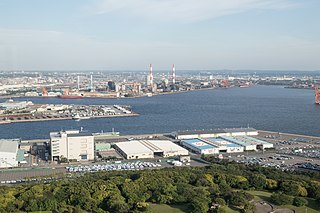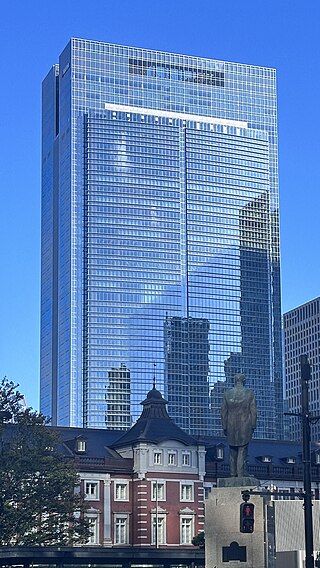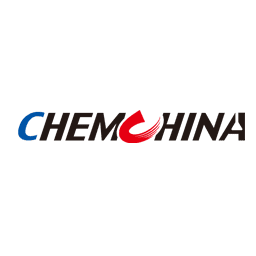
The economy of Trinidad and Tobago is the third wealthiest in the Caribbean and the fifth-richest by GDP (PPP) per capita in the Americas. Trinidad and Tobago is recognised as a high-income economy by the World Bank. Unlike most of the English-speaking Caribbean, the country's economy is primarily industrial, with an emphasis on petroleum and petrochemicals. The country's wealth is attributed to its large reserves and exploitation of oil and natural gas.

The chemical industry comprises the companies and other organizations that develop and produce industrial, specialty and other chemicals. Central to the modern world economy, it converts raw materials into commodity chemicals for industrial and consumer products. It includes industries for petrochemicals such as polymers for plastics and synthetic fibers; inorganic chemicals such as acids and alkalis; agricultural chemicals such as fertilizers, pesticides and herbicides; and other categories such as industrial gases, speciality chemicals and pharmaceuticals.

Petrochemicals are the chemical products obtained from petroleum by refining. Some chemical compounds made from petroleum are also obtained from other fossil fuels, such as coal or natural gas, or renewable sources such as maize, palm fruit or sugar cane.

An oil refinery or petroleum refinery is an industrial process plant where petroleum is transformed and refined into products such as gasoline (petrol), diesel fuel, asphalt base, fuel oils, heating oil, kerosene, liquefied petroleum gas and petroleum naphtha. Petrochemical feedstock like ethylene and propylene can also be produced directly by cracking crude oil without the need of using refined products of crude oil such as naphtha. The crude oil feedstock has typically been processed by an oil production plant. There is usually an oil depot at or near an oil refinery for the storage of incoming crude oil feedstock as well as bulk liquid products. In 2020, the total capacity of global refineries for crude oil was about 101.2 million barrels per day.

Vanillin is an organic compound with the molecular formula C8H8O3. It is a phenolic aldehyde. Its functional groups include aldehyde, hydroxyl, and ether. It is the primary component of the extract of the vanilla bean. Synthetic vanillin is now used more often than natural vanilla extract as a flavoring in foods, beverages, and pharmaceuticals.
Butene, also known as butylene, is an alkene with the formula C4H8. The word butene may refer to any of the individual compounds. They are colourless gases that are present in crude oil as a minor constituent in quantities that are too small for viable extraction. Butene is therefore obtained by catalytic cracking of long-chain hydrocarbons left during refining of crude oil. Cracking produces a mixture of products, and the butene is extracted from this by fractional distillation.
Alagappa College of Technology is an educational institution located in Chennai, Tamil Nadu, India that offers higher education in engineering, technology and allied sciences. The college was established in 1944 and was integrated with Anna University in 1978 from University of Madras as a constituent part of Anna University within its Guindy Campus.
NOVA Chemicals Corporation is a Canadian petrochemical company that has been in operation since 1954. NOVA was formed as provincial crown corporation called the Alberta Gas Trunk Line Company Limited to manage Alberta's natural gas collection system. During the 1970s, the company diversified into petroleum exploration and production, manufacturing, and petrochemicals. In 1980 the AGTL was renamed NOVA, An Alberta Corporation. After a decade of financial struggles, in 1998 NOVA sold its petroleum and pipeline business to TransCanada Pipelines and continued as solely a petrochemicals operation. The gas collection system run by TransCanada is now called the NOVA Gas Transmission Line.

Japan's major export industries include automobiles, consumer electronics, computers, semiconductors, copper, and iron and steel. Additional key industries in Japan's economy are petrochemicals, pharmaceuticals, bioindustry, shipbuilding, aerospace, textiles, and processed foods.

Showa Denko K. K., founded in 1939 by the merger of Nihon Electrical Industries and Showa Fertilizers, both established by a Japanese entrepreneur Nobuteru Mori, is a Japanese chemical company producing chemical products and industrial materials.

The Ministry of Chemicals and Fertilizers in India is the federal ministry with administrative purview over three departments namely:

The Indian Institute of Petroleum (IIP), established in 1960, is one of the 37 constituent laboratories of the Council of Scientific and Industrial Research (CSIR), dedicated to R&D in the hydrocarbon sector.

Mitsui Chemicals is a Japanese chemicals company listed on the Nikkei with business interests in Japan, Europe, China, Southeast Asia and the USA. It is one of the leading chemical companies in Japan and is part of the Mitsui conglomerate. The company mainly deals in performance materials, petrochemicals and basic chemicals and functional polymeric materials.

The emergence of oil production in the territory now known as Romania dates back to 1857, with oil facilities gaining strategic military significance in 1916 during World War I. Throughout World War II, the Kingdom of Romania held the position as the largest oil producer in Europe, second only to the USSR, whose primary oil source was located in Azerbaijan. The oil extracted from Romania played a pivotal role in Axis military operations, a fact underscored in Adolf Hitler's 1942 speech.
Changyi is a county-level city of Weifang, Shandong province, People's Republic of China. The city is 1627.5 square kilometers in area, with a household population of 581,000 as of 2010. The city is under the administration of the Changyi Municipal People's Government, with three neighborhoods, six towns, 691 administrative villages, and one special economic development zone. Changyi has a long history that extends back into the Spring and Autumn period.
The North East of England Process Industry Cluster (NEPIC) is an economic cluster developed in accordance with Michael Porter's theories and strategies regarding industrial clusters. The chemistry-using sectors in North East England, where more than 1,400 businesses are headquartered in the industry's supply chain, formed this Process Industry Cluster. In the north-east of England, the industry employs approximately 35,000 direct workers and around 190,000 indirect workers, who collectively account for more than one-third of the area's industrial economy. Companies in the cluster produce 35% of the pharmaceuticals and 50% of the petrochemicals used in the UK, making this area the only net exporter of goods from the country. The area has more than £13 billion in exports.
Specialty chemicals are particular chemical products which provide a wide variety of effects on which many other industry sectors rely. Some of the categories of speciality chemicals are adhesives, agrichemicals, cleaning materials, colors, cosmetic additives, construction chemicals, elastomers, flavors, food additives, fragrances, industrial gases, lubricants, paints, polymers, surfactants, and textile auxiliaries. Other industrial sectors such as automotive, aerospace, food, cosmetics, agriculture, manufacturing, and textiles are highly dependent on such products.

China National Chemical Corporation, commonly known as ChemChina, is a Chinese state-owned chemical company in the product segments of agrochemicals, rubber products, chemical materials and specialty chemicals, industrial equipment, and petrochemical processing for the civilian and military sectors. As of 2020, it is ranked 164th among the Fortune Global 500 companies.
American Fuel and Petrochemical Manufacturers (AFPM) is an American trade association, founded in 1902 as the National Petroleum Association. It became the National Petroleum Refiners Association in 1961, the National Petrochemical & Refiners Association in 1998 and became the AFPM in 2012. AFPM is a trade association representing American manufacturers of virtually the entire U.S. supply of gasoline, diesel, jet fuel, other fuels and home heating oil, and petrochemicals. AFPM represents companies including Chevron Corporation, ExxonMobil, Koch Industries, Marathon Petroleum and Valero Energy.
ISO 10628Diagrams for the chemical and petrochemical industry specifies the classification, content, and representation of flow diagrams. It does not apply to electrical engineering diagrams. ISO 10628 consists of the following parts:











